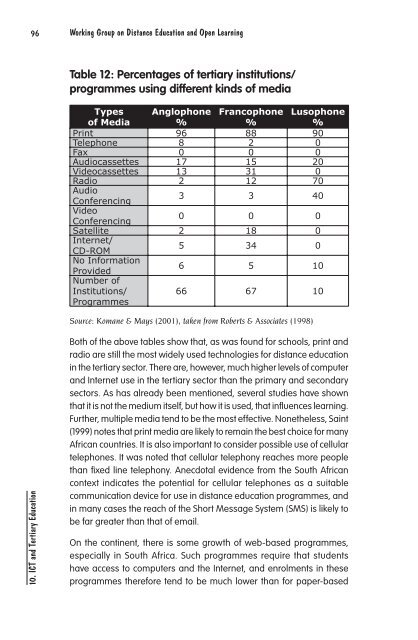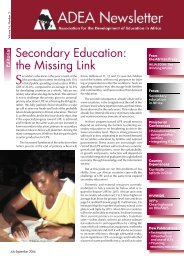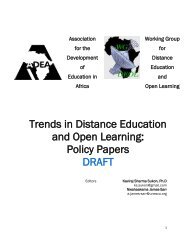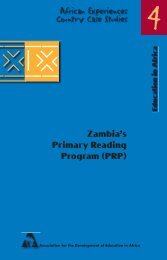Technological Infrastructure and Use of ICT in Education in ... - ADEA
Technological Infrastructure and Use of ICT in Education in ... - ADEA
Technological Infrastructure and Use of ICT in Education in ... - ADEA
Create successful ePaper yourself
Turn your PDF publications into a flip-book with our unique Google optimized e-Paper software.
96 Work<strong>in</strong>g Group on Distance <strong>Education</strong> <strong>and</strong> Open Learn<strong>in</strong>g<br />
Table 12: Percentages <strong>of</strong> tertiary <strong>in</strong>stitutions/<br />
programmes us<strong>in</strong>g different k<strong>in</strong>ds <strong>of</strong> media<br />
Types<br />
<strong>of</strong> Media<br />
Anglophone<br />
%<br />
Francophone<br />
%<br />
Lusophone<br />
%<br />
Pr<strong>in</strong>t 96 88 90<br />
Telephone 8 2 0<br />
Fax 0 0 0<br />
Audiocassettes 17 15 20<br />
Videocassettes 13 31 0<br />
Radio 2 12 70<br />
Audio<br />
Conferenc<strong>in</strong>g<br />
3 3 40<br />
Video<br />
Conferenc<strong>in</strong>g<br />
0 0 0<br />
Satellite 2 18 0<br />
Internet/<br />
CD-ROM<br />
5 34 0<br />
No Information<br />
Provided<br />
6 5 10<br />
Number <strong>of</strong><br />
Institutions/<br />
Programmes<br />
66 67 10<br />
Source: Komane & Mays (2001), taken from Roberts & Associates (1998)<br />
10. <strong>ICT</strong> <strong>and</strong> Tertiary <strong>Education</strong><br />
Both <strong>of</strong> the above tables show that, as was found for schools, pr<strong>in</strong>t <strong>and</strong><br />
radio are still the most widely used technologies for distance education<br />
<strong>in</strong> the tertiary sector. There are, however, much higher levels <strong>of</strong> computer<br />
<strong>and</strong> Internet use <strong>in</strong> the tertiary sector than the primary <strong>and</strong> secondary<br />
sectors. As has already been mentioned, several studies have shown<br />
that it is not the medium itself, but how it is used, that <strong>in</strong>fluences learn<strong>in</strong>g.<br />
Further, multiple media tend to be the most effective. Nonetheless, Sa<strong>in</strong>t<br />
(1999) notes that pr<strong>in</strong>t media are likely to rema<strong>in</strong> the best choice for many<br />
African countries. It is also important to consider possible use <strong>of</strong> cellular<br />
telephones. It was noted that cellular telephony reaches more people<br />
than fixed l<strong>in</strong>e telephony. Anecdotal evidence from the South African<br />
context <strong>in</strong>dicates the potential for cellular telephones as a suitable<br />
communication device for use <strong>in</strong> distance education programmes, <strong>and</strong><br />
<strong>in</strong> many cases the reach <strong>of</strong> the Short Message System (SMS) is likely to<br />
be far greater than that <strong>of</strong> email.<br />
On the cont<strong>in</strong>ent, there is some growth <strong>of</strong> web-based programmes,<br />
especially <strong>in</strong> South Africa. Such programmes require that students<br />
have access to computers <strong>and</strong> the Internet, <strong>and</strong> enrolments <strong>in</strong> these<br />
programmes therefore tend to be much lower than for paper-based

















